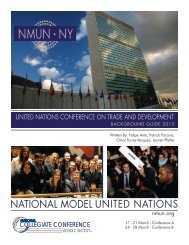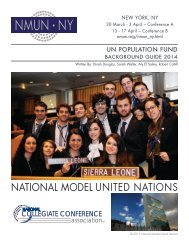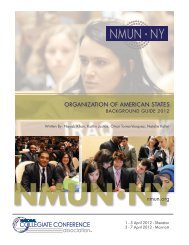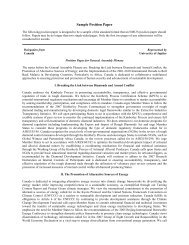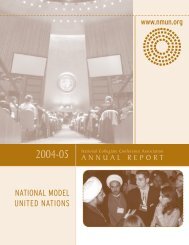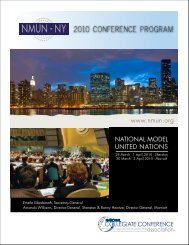NMUN • KOREA - National Model United Nations
NMUN • KOREA - National Model United Nations
NMUN • KOREA - National Model United Nations
Create successful ePaper yourself
Turn your PDF publications into a flip-book with our unique Google optimized e-Paper software.
International experts agree that the 2 °C goal is an important threshold to prevent the most severe consequences of<br />
climate change. 36<br />
It is particularly noteworthy that the decision does not recommend specific methods or instruments that should be<br />
included in the post-2020 agreement, but rather outlines a “laundry list” of general goals including “mitigation,<br />
adaptation, finance, technology development and transfer, transparency of action and support, and capacity-building,<br />
drawing upon submissions from Parties and relevant technical, social and economic information and expertise.” 37<br />
Since the document also makes no reference to the distinction of responsibilities for developing and industrialized<br />
countries – the “principle of common but differentiated responsibilities and respective capabilities (CBDRRC)” –<br />
and does not stress that rich countries should “take the lead”, the 2011 outcome gives way to a more open<br />
negotiation space where many structural conditionalities from previous negotiation rounds are put into question. 38<br />
The negotiations and periodic meetings of the ADP, referred to as the Durban process, are currently underway.<br />
Since decision 1/CP.17 clearly says that the ADP’s work “shall be terminated” by the twenty-first UNFCCC<br />
Conference of Parties in Paris in 2015, a certain degree of urgency accompanies the negotiating process. 39 To meet<br />
this, the ADP adopted in 2012 an agenda that outlines two major “workstreams”: The first concentrates on the 2015<br />
agreement while the second concentrates on pre-2020 ambitions. 40<br />
As of today, it is difficult to conclusively assess which agreement the ADP will suggest when it finishes its work in<br />
2015. Looking at one of the more recent negotiating meetings, in June 2013 in Bonn, the current status quo can be<br />
summarized along six major preliminary findings:<br />
i. There is a universal responsibility to protect the climate as “all Parties need to take ambitious action” to<br />
achieve the 2°C target;<br />
ii. The principles of equity and CBDRRC command that commitments should be fair and not hinder<br />
sustainable development;<br />
iii. A form of support for Parties with inadequate means has to be provided;<br />
iv. Proposed mitigation efforts have to be “transparent, quantifiable and comparable”;<br />
v. To reach and maintain the scientifically required level of commitments, there has to be a mechanism to<br />
review and, if necessary, “scale up” nationally proposed mitigation commitments; and<br />
vi. “Indicators”, or contribution targets, are considered to be useful to develop and compare national efforts. 41<br />
Regional Economic Integration Organizations and the Durban Process<br />
Generally, there is a “multiplicity of intergovernmental regional environmental efforts.” 42 However, the European<br />
Union is the only regional economic integration organization (REIO) with the status of Party to both the UNFCCC<br />
and the Kyoto Protocol. This underlines the fact that, outside of Europe, virtually all of the other regional economic<br />
integration organizations have at most a coordinating or advising stance on climate policy, and leave the policymaking<br />
to nation states. Examples for advisory roles for regional bodies are the regional economic commissions of<br />
the UN, or strictly intergovernmental bodies like the Association of Southeast Asian States (ASEAN). 43 Since the<br />
EU plays a particularly important role in the negotiating process of global climate change politics, the following<br />
section will focus on this aspect.<br />
The European Union’s approach to the Durban process<br />
The European Union (EU) was a key player at the negotiations in Durban. Together with the group of Small Island<br />
States and Least Developed Countries, the EU lobbied hard for a legally binding climate treaty that would also<br />
36 UNEP, The 2012 Emissions Gap Report, 2012.<br />
37 Bodansky, The Durban Platform Negotiations, 2012, p. 3; UNFCCC Conference of Parties, Establishment of an Ad Hoc<br />
Working Group on the Durban Platform, 2012, Clause 5.<br />
38 Bodansky, The Durban Platform Negotiations, 2012, p. 3.<br />
39 UNFCCC Conference of Parties, Establishment of an Ad Hoc Working Group on the Durban Platform, 2012, Clauses 1, 3.<br />
40 UNFCCC, Report of the Ad Hoc Working Group on the Durban Platform for Enhanced Action, 2012.<br />
41 Irish Presidency of the Council of the European Union, Process for Ensuring Ambitious Mitigation Commitments in the 2015<br />
Agreement, 2013.<br />
42 Breslin & Elliott, Researching comparative regional environmental governance, 2011, p. 4.<br />
43 Yan & Zhimin, Europe, Asia and Climate Change Governance, 2013.



